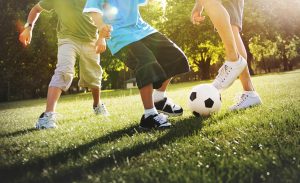Stay active, strong and enjoy life: Tips for strong joints, bones and muscles
Published July 5, 2023
What do you do to escape the stresses of the everyday? Bushwalking, playing golf or working in the garden? Looking after your joint, muscle and bone health will ensure you have the physical fitness and freedom to keep doing the activities you love and live life to the full.
Looking after your joints
Your body has different types of joints; some joints move freely, others don’t. Your joints are grouped by their function or by the kind of connective tissue they contain.[1] Your main functional joints work hard to prevent friction between your bones as you move your body. Over time the cartilage in these joints can become damaged or too thin, especially if the joint has experienced long-standing stress, such as an injury or excessive body weight. This reduction in cartilage puts increased pressure on your bones, leading to swelling, mild pain, and stiffness of the joint.1
Protecting your joints as you age doesn’t have to be difficult. There are several diet and lifestyle tips you can start today to keep your joints healthy:
Healthy weight and joint health
Maintaining a healthy weight reduces the stress on your joints, helping them stay strong and healthy.[2]
Exercise for your joints
Exercise may be beneficial for joint health. Exercise for a minimum of 150 minutes per week is a popular recommendation to maintain a healthy weight and support joints.2 Weight-bearing exercise promotes joint health, physical function and quality of life.[3]
Glucosamine and joints
Glucosamine is a natural compound found in the body, with a high concentration in joints. Glucosamine has been shown to support joint mobility and reduce mild joint stiffness in mild osteoarthritis.[4]
Celery seeds for mild rheumatic aches and pains
Celery seeds have been used in traditional Western herbal medicine to reduce mild rheumatic aches and pains.[5].[6]
Curcumin
The herb curcumin has been used in traditional Western herbal medicine to relieve mild joint pain and inflammation associated with mild osteoarthritis, helping you alleviate mild stiffness in the joints.[7]
Strong muscles — the key to longevity
Muscles can change as you age; these changes can include loss of muscle mass, strength and function. For example, muscle mass decreases by 3-8% per decade after the age of thirty, with the rate of decline increasing after sixty. Helping prevent loss of muscle mass protects you from falls, injury and illness as you age.8 Maintaining muscle mass and strength through exercise, healthy eating and supplementation can help support healthy muscle function, giving your muscles what they need to keep you moving.
Exercise and muscle health
Short-term muscle inactivity has been shown to reduce muscle mass and strength, even in young people. Both resistance training and aerobic exercise can improve muscle health. Resistance training (e.g. weights training) has been shown to increase muscle and strength in adults, including the elderly and physically frail adults. Aerobic exercise has been shown in preliminary trials to increase muscle protein synthesis in healthy older adults.[8] Speak to your doctor about which exercise program is right for you.
Protein and muscle health
Eating a balanced diet will help your muscles get the nutrients they need, including macronutrients like protein. Protein in foods contain amino acids; these amino acids are the building blocks of muscle tissue. Nine of these amino acids are essential as our body can’t make them and you must get them through your diet. Sources of protein include meat, poultry and fish, cereals and dairy foods.[9]
Magnesium helps muscles work
A third of your body’s magnesium is found in muscles and soft tissues. Magnesium helps your muscles work properly. Look for it in leafy green vegetables, nuts, peas and legumes.[10]
Vitamin D3 supports muscle function
Muscles contain Vitamin D3 receptors and studies have shown that vitamin D may help support muscle function and muscle strength in the elderly.[11]
Strong bones for life
Your bones are your body’s quiet achievers; they’re working hard to help you move and keep you strong. Every day, your body breaks down old bone and puts new bone in its place. Unfortunately, as you get older, your bones break down more bone than they put back. While it’s normal to lose some bone as you age, if you don’t look after your bones, you can lose too much and negatively impact your health.
Your diet and lifestyle affect the health of your bones and how well their break down and put back cycle works. Taking good care of your bones today means they can take good care of you as you age. Try these bone-strengthening tips:
Exercise for strong bones
Exercising not only benefits your bones but also improves your balance and strength, helping prevent falls and injuries. Exercises like Tai Chi, Yoga or walking help improve bone strength and balance.[12]
Boost your sunshine vitamin
Vitamin D, also known as the sunshine vitamin, helps healthy bone development and helps the body absorb calcium. Find Vitamin D in egg yolks, fish, liver and foods fortified with vitamin D. Spending a few minutes in the sun (always follow sun-safe guidelines) will also help you boost your vitamin D levels.12
Are you getting enough calcium?
Your body combines calcium with other minerals to build strong bones and give them structure. Good sources of calcium include dairy foods, canned fish, firm tofu, leafy green vegetables, nuts and legumes.[13]
Live a healthy lifestyle
Taking care of your joints, muscles and bones helps you enjoy life every day. Getting out into the sunshine, doing a sport or activity you love will ensure your bones, joints and muscles are well looked after, so they can look after you!
Cenovis® has a range of products designed to support joint, bone and muscle health. Click here to learn more.
Always read the label and follow the directions for use.
[1] Juneja P, Munjal A, Hubbard JB. Anatomy, Joints. 2021 Jul 26. In: StatPearls [Internet]. Treasure Island (FL): StatPearls Publishing; 2021 Jan–. PMID: 29939670.
[2] Connelly AE, Tucker AJ, Kott LS, Wright AJ, Duncan AM. Modifiable lifestyle factors are associated with lower pain levels in adults with knee osteoarthritis. Pain Res Manag. 2015 Sep-Oct;20(5):241-8.
[3] Bennell K, Nelligan R, Kimp A, Schwartz S, Kasza J, Wrigley T et al. What type of exercise is most effective for people with knee osteoarthritis and co-morbid obesity?: The TARGET randomized controlled trial. Osteoarthritis and Cartilage. 2020;28(6):755-765.
[4] Zhu X, Sang L, Wu D, Rong J, Jiang L. Effectiveness and safety of glucosamine and chondroitin for the treatment of osteoarthritis: a meta-analysis of randomized controlled trials. J Orthop Surg Res. 2018 Jul 6;13(1):170.
[5] Salehi B, Venditti A, Frezza C, Yücetepe A, Altuntaş Ü, Uluata S et al. Apium Plants: Beyond Simple Food and Phytopharmacological Applications. Applied Sciences. 2019;9(17):3547.
[6] Loef M, Schoones J, Kloppenburg M, Ioan-Facsinay A. Fatty acids and osteoarthritis: different types, different effects. Joint Bone Spine. 2019;86(4):451-458.
[7] WHO Monographs on Selected Medicinal Plants – Volume 1: Rhizoma Curcumae Longae [Internet]. Digicollection.org. 2021 [cited 1 September 2021]. Available from: http://digicollection.org/hss/en/d/Js2200e/14.html#Js2200e.14
[8] Volpi E, Nazemi R, Fujita S. Muscle tissue changes with aging. Curr Opin Clin Nutr Metab Care. 2004 Jul;7(4):405-10.
[9] Protein|Nutrient Reference Values [Internet]. Nutrient Reference Values for Australia and New Zealand. 2021 [cited 1 September 2021]. Available from: https://www.nrv.gov.au/nutrients/protein
[10] Magnesium [Internet]. Nutrient Reference Values for Australia and New Zealand. 2021 [cited 2 September 2021]. Available from: https://www.nrv.gov.au/nutrients/magnesium
[11] Halfon M, Phan O, Teta D. Vitamin D: A Review on Its Effects on Muscle Strength, the Risk of Fall, and Frailty. BioMed Research International. 2015;2015:1-11.
[12] Bone Health for Life: Health Information Basics for You and Your Family | NIH Osteoporosis and Related Bone Diseases National Resource Center [Internet]. Bones.nih.gov. 2021 [cited 2 September 2021]. Available from: https://www.bones.nih.gov/health-info/bone/bone-health/bone-health-life-health-information-basics-you-and-your-family
[13] Calcium [Internet]. Healthdirect.gov.au. 2021 [cited 2 September 2021]. Available from: https://www.healthdirect.gov.au/calcium
Learn about which Cenovis product may be appropriate for you.
SEE THE PRODUCTS HERE










